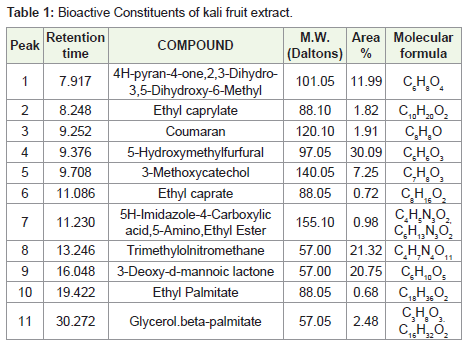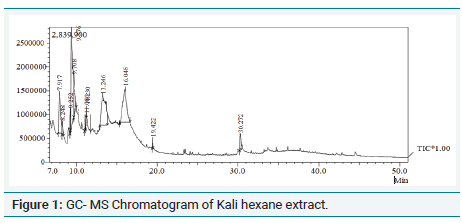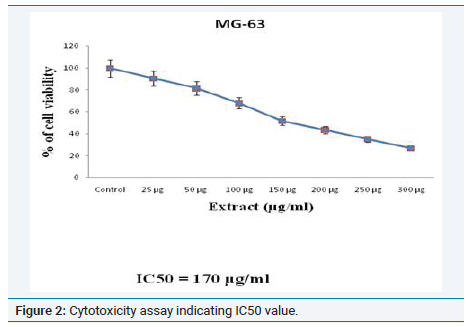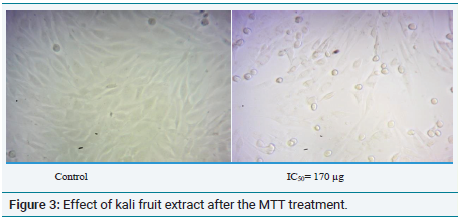Research Article
Antitumor Activities of KALI Banana Fruit in MG-63 Cell Line
Anu A and Geethalashmi S*
Department of Biotechnology, Sree Narayana Guru College, Coimbatore, India
*Corresponding author: Geethalasmi S, Associate professor, Department of Biotechnology, Sree Narayana Guru
College, Coimbatore, India; E-mail: s.geethalakshmi@gmail.com
Copyright: © Anu A, et al. 2019. This is an open access article distributed under the Creative Commons Attribution License, which
permits unrestricted use, distribution, and reproduction in any medium, provided the original work is properly cited.
Article Information: Submission: 09/10/2019; Accepted: 11/11/2019; Published: 13/11/2019
Abstract
Banana natural products are broadly utilized for human consumption. It is the second real nourishment crop in India. There are around 365 varieties of
bananas available throughout the world. It is utilized as conventional medication for bowel disorders. This study aimed at examining the anticancer activity of
Kali variety of banana which is commonly consumed in southern part of India. Anticancer examination of the sample was performed for the ethanolic extract
using MG-63 cell lines which showed a high degree of anticancer activity which was proved by the cytotoxic effect on MG-63 tumor cell lines. Phytochemicals
present in the plant concentrate provoked cell apoptosis and smoother cell expansion to quickly partitioning malignancy cell lines. The kali variety shows
increased level of anti cancer activity in both cell lines. So we can use this variety in oral medicine for cancer treatment.
Keywords
MG-63; Kali banana fruit; Bioactive compounds; Apoptotic index; Phenols; Flavanoids
Introduction
Malignancy is a strange cell development with the potential to
spread to other parts of the body (WHO, 2018). According to ASCO
information, men have a high occurrence rate of bone marrow
cancer than women. Genetic disorders, hereditary, exposure to toxic
chemicals like solvents, fuels, certain cleaning products, radiation
cause bone marrow cancer in human. There are 1660 death (960 men
and 700 women) from this disease in 2018. A huge number of patients
show resistance to tamoxifen, the currently available high potent drug
for treating bone marrow cancer and experience extreme reactions.
Other treatment methods like chemotherapy, radiation and bone
marrow transplantation result in serious side effects which complicate
the current situation. So, medical research focuses on natural
methods to cure cancer without additional side effects. Numerous
fruits like guava, banana [1], papaya, apple, watermelon, litchi have
been accounted to have demonstrated therapeutic properties in
several studies [1-6].
Kali is a local name of kali vazha which is a traditional variety of
banana in South India. It is a wild type of banana and it cultivated
in hill area in Kerala. This variety is used as traditional medicine in
Kerala. The fruit occur as a bunch weighing 6-8 kg. Presently, this
variety is endangered because of climatic change and modernization
of agriculture techniques. The kali fruit is a rich source of crude protein
(6-7%), crude fat (9-12%) and total ash (7.6%). Natural bioactive
compounds such as steroids, flavonoids, tannins, phenol, Saponins,
alkaloids, glycosides are found in the mature fruit. Pieces of banana
have for some time been utilized in customary medication in Asia
and Africa for treating wounds, decrease pain, for cell rejuvenation,
antimicrobial agent and many more [4,6-9].
This study has been aimed at analyzing the anticancer activity
of Kali fruit with reduced risk [5,8-12]. The present investigation
was directed to profile the bioactive compounds in kali pulp and to
evaluate its ability of cancer prevention and analyze its capacity to
hinder the expansion of human bone osteosarcoma cells using MG-
63 cell line.
Materials and Methods
Kali fruit was collected from Attapady, Palakkad district, Kerala,
India. The peel was removed from fruit, the pulp was collected, shade
dried at room temperature for 40 days, powdered and stored at 4 °C
until further use.
Preparation of plant extract:
Ten gram of dry fruit powder was dissolved in 100 ml of hexane
in a conical flask and kept for 24 hours in a shaker. The mixture was
then filtered twice using Whatman No. 1 filter paper and stored at
4°C.Qualitative analysis of secondary metabolites:
GC-MS investigation of plant concentrates was performed using
Shimadzu GC-MS hardware of model QP 2010S containing Rxi-5
ms combined silica narrow section of 30 m length, 0.25 mm distance
across and film thickness of 0.25 μm. This analysis was done to find
the metabolites present in the extract.Cell line maintenance:
Human MG63 cell lines were obtained from National Center
for Cell Sciences (NCCS), Pune, India. Dulbecco’s Modified Eagle
Media (DMEM) was utilized for maintaining the cell line, which was
enhanced with 10% Fetal Bovine Serum (FBS). Penicillin (100 U/ml)
and streptomycin (100 μg/ml) were added to the medium to prevent
bacterial contamination. The medium with cell lines was kept in a
humidified environment with 5% CO2 at 37 °C.Cytotoxicity assay:
The MG-63 cells were placed in 24 well plates (1 X 105 cells per
well) and incubated in 5% CO2 environment at 37 °C. Cells (1X105/
well) were placed in 24-well plate and incubated in 37 °C with 5%
CO2 condition. Once the cells reached confluence, the prepared
concentrations of extract (25 - 300 μg/ml) were added and kept in
incubator for 24 hours. Then the samples were removed from the
well and washed with phosphate-buffered saline (pH 7.4) or DMEM
without serum. 0.5% of 3-(4,5-dimethyl-2-thiazolyl)-2,5-diphenyl-
Tetrazolium Bromide (MTT) was added to each well (100 μl/well)
and incubated for 4 hours. Then 1 ml of Dimethyl Sulfoxide (DMSO)
was added in all the wells to dissolve the formazan crystals. Each
sample was placed in the cuvette; using DMSO as the blank the
absorbance value at the wavelength of 570 nm was noted using Ultra-
Violet (UV) Spectrophotometer in triplicate. The observed values
were tabulated and the concentration required for 50% inhibition
(IC50) was determined graphically. The percentage cell viability was
calculated by determining the ratio between treated MG-63 cells and
control multiplied by 100.Result and Discussion
The hexane extract of the fruit was analyzed for secondary
metabolites using GC-MS analysis and the chromatogram and the list
of bioactive compounds present in the extract (Figure 1 and Table 1).
The GC-MS chromatogram showed an intense peak at RT 9.376,
a second large peak at RT 13.246 and least peak at RT 19.422. The
larger peak showed a mass by charge ratio of 155.10 (Figure 1). This m/z ratio does not correlate with any of the prior revealed anticancer
bioactive mixes as per the verification in anticancer database and thus
has all the earmarks of being a novel one.
The anticancer properties of the pulp with its tumor necrosis factor
activity were already reported by many researchers [4,12,13]. MG-
63 cell line is a model system for bone cancer studies and apoptosis
process in cell. As per literature cited, with a high concentration
of bioactive compounds like phenols and flavonoids, high intense
anticancer activity can be observed on MG-63 cells [14-18]. Many
treatments are used currently in cancer treatment like chemotherapy
which, at primary stage, gives good response but it creates resistance in
the later stage of cancer. In the present study, different concentration
of fruit extract showed various levels of inhibitory action on MG-63
cell lines. Increase in concentration of the extract from 25 μg /ml to
300 μg /ml showed a decrease in cell viability of MG-63 from 90.14 to
26.7 % (Figure 2 and 3). The IC50 value of the fruit extract was found
to be 170 μg/ml [19-21].
Conclusion
From the present study, it is clear that the hexane concentrate of
kali fruit extracts has a strong cytotoxic activity against MG-63 bone
cancer. The fruit have broad spectrum of bioactive compounds which
is anticancer active, which is seen from GC-MS chromatogram.
Further research is needed to distinguish the bioactive compounds in
banana, their refinement and interpretation of their activity to utilize
the fruit pulp in pharmaceutical industries.
Acknowledgement
The authors are grateful for the cooperation of the SCIGEN
Research Lab, Staff of Department of Biotechnology, Sree Narayana
Guru College for necessary support. Technical support from Dr.
S. Geethalakshmi, Associate Professor and Head, Department of
Biotechnology, Sree Narayana Guru College is also acknowledged.




